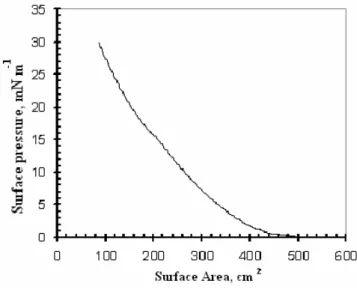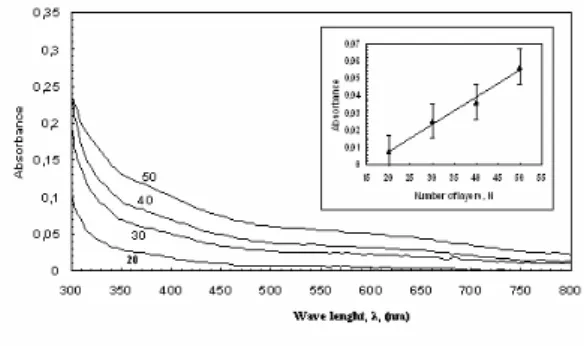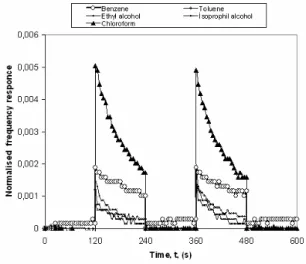See discussions, stats, and author profiles for this publication at: https://www.researchgate.net/publication/262489851
Characterization of a Novel 1,3-Bis(4-Imino-3 Hydroxybenzoicacid) Indane
Langmuir-Blodgett Film For Organic Vapor Sensing
Article in Journal of Optoelectronics and Advanced Materials · June 2007
CITATION
1
READS
46
5 authors, including:
Some of the authors of this publication are also working on these related projects:
Thin film research (Çanakkale-Balikesir Group)View project
Developing Polymeric Langmuir-Blodgett (LB) Thin Film Sensors To Determine The Harmful Organic Vapors for Human and Environment HealthView project Y. Acikbas Usak Üniversitesi 30 PUBLICATIONS 179 CITATIONS SEE PROFILE Rifat Capan Balikesir University 89 PUBLICATIONS 697 CITATIONS SEE PROFILE Hilmi Namli Balikesir University 42 PUBLICATIONS 672 CITATIONS SEE PROFILE Onur Turhan Balikesir University 17 PUBLICATIONS 98 CITATIONS SEE PROFILE
All content following this page was uploaded by Y. Acikbas on 22 May 2014. The user has requested enhancement of the downloaded file.
Invited Lecture
Characterization of a novel
1,3-bis(4-imino-3-hidroxy-benzoicacid)indane Langmuir-Blodgett film for organic
vapour sensing
Y. AÇIKBAŞ, R. ÇAPAN*, H. NAMLIa, O. TURHANa, G. A. STANCIUb
Balikesir University, Science Faculty, Physics Department, 10100 Balikesir Turkey a
Balikesir University, Science Faculty, Chemistry Department, 10100 Balikesir Turkey b
Center of Microscopy-Microanalysis and Information Processing, University 'Politehnica' of Bucharest, 313 Splaiul Independenteti, 060032, Bucharest, Romania
A Langmuir-Blodgett (LB) thin film deposition technique is used to characterise a novel 1,3-Bis(4-imino-3-hydroxybenzoicacid) indane material on the water surface, and to transfer it as an ultra-thin LB film layer onto solid substrates. Another aim of this work is to study the gas sensing properties of this novel material, using several organic vapors. UV-visible, Atomic Force Microscopy and Quartz Crystal Microbalance results show that a high quality and uniform LB film can be produced using this molecule and the LB film sample is found to be significantly more sensitive to chloroform and benzene vapors than others organic vapors used in this work. The response, in terms of frequency change to the exposure of these vapors, is fast, large and reversible. This material may find potential applications in the development of room temperature organic vapor sensing devices and this newly synthesised indanediimine material has a potential advantage as an LB film material compared to other traditional LB film materials.
(Received November 1, 2006; accepted December 21, 2006)
Keywords: Langmuir-Blodgett (LB) thin film, Indanediimine, Organic vapor, Gas sensor
1. Introduction
Organic materials have been widely studied in the field of gas sensing applications because of their easy synthesises, high control of molecular structure and low cost. A Langmuir-Blodgett (LB) film deposition technique is a suitable method to organise organic materials on the water surface and to transfer them onto a solid substrate as a thin film form. The gas sensing properties of several organic LB materials such as porphyrin [1,2], calixarene [3,4], phthalocyanine [5,6] and poly(methyl methacrylate) [7] have been studied using different organic or inorganic gases. There is very limited information in the literature on the study of indandione-based materials [8,9]. An LB thin film of a newly synthesised 1,3-bis-(p-iminobenzoic acid) indane containing polar carboxylic acid groups was used to investigate the organic vapor sensing properties [10]. The results showed that this kind of indanediimine material is sensitive to benzene vapor and the response of the LB sample is fast, large and reversible.
In this study, the novel 1,3-bis-(4-imino-3-hydroxybenzoicacid) indane (IHBI) material is selected as the organic LB thin film material. The Langmuir properties at the air-water interface and the deposition conditions of LB are studied using an alternate layer LB trough. UV-Visible Spectrophotometer, Atomic Force Microscope (AFM) and Quartz Crystal Microbalance (QCM) systems are used to investigate the structure of LB film multilayers on glass or quartz crystal substrates. The
organic vapour sensing properties of an LB film using this IHBI material will be reported in here, for the first time.
2. Experimental details
IHBI was synthesized by the reaction of 1,3-indanedione with 4-amino-3-hydroxybenzoic acid at room temperature in ethanol. The mixture was stirred overnight before filtration and re-crystallization in ethanol. The chemical structure of the IHBI material used in this work is shown in Fig. 1, and it was dissolved in a 9:1 ratio of chloroform and methanol with a ratio of concentration
approximately 0.25 mg ml-1. This solution was used to
take an isotherm and to produce a LB film by spreading it on the distilled water surface. A time period of 15 minutes was allowed for the solvent to evaporate before the area enclosed by the barriers was reduced. The temperature of the water subphase was controlled using a Lauda Ecoline RE 204 model temperature control unit and all experimental data were taken at room temperature. The Π-A isotherm graph of the IHBI was recorded as a function of surface area at pH 6.0 and the compression speed for
the monolayer was controlled at 1000 mm min-1. The
isotherm graph was repeated several times and the results were found to be reproducible. The area per molecule, a, was calculated using the expression [11]:
Characterization of a novel 1,3-bis(4-imino-3-hidroxybenzoicacid)indane Langmuir-Blodgett film for organic vapour sensing 57
V
N
c
M
A
a
A w=
(1)where A is the enclosed area, Mw is molecular weight of
the material, c is the concentration of the solution, V is the volume of the solution spread onto the water surface and
NA is Avogadro's number.
Fig. 1. The chemical structure of the material.
LB films were deposited onto glass substrates for UV-visible and AFM, and onto quartz crystals for QCM measurements at room temperature, using a NIMA LB 622
Trough (Coventry, England) with an area of 1200 cm2.
The deposition pressure and deposition mode were
22.5 mN m-1 and Y-type respectively. Different numbers
of monolayers were deposited on quartz substrates for UV-visible spectroscopy. The UV-UV-visible spectra of the LB films were recorded in the ultraviolet and visible spectral regions from 300 nm to 800 nm, using a VARIAN CARY 1E UV-visible spectrophotometer in the absorbance mode. A Quesant 350 Scanning Probe Microscope was employed for Atomic Force Microscopy measurements. The scale was set in such a way that light colours correspond to higher structures. The images were taken using a standard silicon nitride tip (constant force 12N/m) in the contact mode.
A quartz substrate with a sandwich structure between two electrodes was used for the QCM measurements, performed at room temperature using an in-house designed oscillating circuit and standard quartz crystal with a nominal resonance frequency of 4 MHz. The frequency was measured with a MOTECH FG-513 model function generator and a TEKTRONIX TDS 210 model digital oscilloscope. This technique was employed to monitor the successive deposition of the monolayers and to confirm the reproducibility of the LB film deposition process. The QCM system was also applied to display the kinetic response of the LB sample against organic vapors. A special gas cell was constructed to study the kinetics of the organic vapor properties of the IHBI LB films on exposure to chloroform, benzene, toluene, ethyl alcohol and isopropyl alcohol vapors, by measuring the frequency changes. The variation of the frequency changes was monitored as a function of time, when the sample was periodically exposed to the organic vapors for at least 2 minutes, and was then allowed to recover after injection of dry air.
3. Experimental results
Fig. 2 shows the isotherm graph of a IHBI monolayer obtained by reducing the surface area. The surface
pressure starts rising at an area around 0.3 nm2,
determined using Eq. 1, and gradually increases upon
compression until the surface pressure rises to nearly
30 mN m-1. A similar study was carried out in our previous
work, using a 1,3-bis-(p-iminobenzoic acid) indane (IBI) material, and a similar isotherm graph was observed [10].
From this, a surface pressure of 22.5 mN m-1 was chosen
for all deposition processes, and the transfer ratio was ~ 0.90 for Y-type LB films deposited on glass and the QCM substrates.
Fig. 2. Isotherm graph of IHBI.
The reproducibility of LB film multilayers on quartz crystals can be tested by a QCM measurement system, because of the high sensitivity to small mass changes. The resonant frequency is a function of mass changes and is given by [12]:
m
A
f
2
f
1/2 q 2 / 1 q 2 0Δ
μ
ρ
−
=
Δ
(2)where Δf is the measured frequency shift, is the
resonant frequency of the fundamental mode of the crystal, Δm is the mass change per unit area, A is the piezoelectrically active area, ρ
0
f
q is the density of quartz and
μq is the shear modulus of quartz.
Fig. 3 shows a plot of the change in the resonant frequency against the number of deposited layers for a IHBI LB film.
Fig. 3. A plot of the change in the resonant frequency, as a function of the number of layers.
This linear relationship suggests that an equal mass per unit area is deposited onto the quartz crystal and a high quality and uniform LB film structure is fabricated in this work. The mass deposited on the quartz crystal per layer for a 4 MHz oscillator was determined as 41 ng using Eq. 2. Using a novel 1,3-bis-(p-iminobenzoic acid) indane material, similar deposition trends has been found, and indanedione materials can be good LB film materials because of their linear decrease in the frequency shift [10]. As a result of this, these novel indanedione materials will be an alternative to other traditional LB film materials.
Fig. 4 shows typical UV-visible absorption spectra of an IHBI solution in 80:20 % chloroform and DMSO respectively.
Fig. 4. UV-vis. spectra of IHBI in the solution.
The spectra of the solution between 300-700 nm exhibit absorption bands at 335, 420 and 540 nm. The absorption peaks at 335 nm and 420 nm occur due to the n−π∗ transition from an OH and N electron pairs to the benzene ring, respectively. The over conjugation of the whole molecule also gives the peak at 540 nm.
In an attempt to determine the quality of LB film multilayers on glass substrates, the relationship between the absorbance and film thickness was investigated. A linear dependence of the absorbance on the number of layers could be obtained, indicating the reproducible film deposition onto glass substrates. Fig. 5 displays the UV-Visible absorption spectra of IHBI LB films with different numbers of layers. It can be seen that the intensities of the absorption peaks increased as a function of film thickness. The inset in Fig. 5 shows a plot of the absorbance at 540 nm of the deposited IHBI LB films versus the number of LB film layers, up to 50 layers. The four points indicate a
linear increase, which is actually confirmed by the QCM data. In the latter, indeed it is shown that the amount of material deposited is the same in each deposition step.
Fig. 5. UV-visible absorption spectra of IHBI LB film with a different number of layer.
Atomic Force Microscopy (AFM) in contact mode was employed to investigate the morphology of a IHBI LB
film deposited at a rate of 1000 mm min−1 onto an
optically flat hydrophilic glass substrate, using a value of
the surface pressure of 22.5 mN m-1. Fig. 6 shows a
three-dimensional AFM image for a 10 layer LB film, and this sample exhibited a smooth, compact, uniform and void free morphology.
Fig. 6. AFM image for a 10 layer LB film sample.
The kinetic response of the LB sample to the benzene
(C6H6), toluene (C7H9), isoprophyl alcohol (C3H8O), ethyl
alcohol (C2H5OH) and chloroform (CHCl3) vapors was
recorded by measuring the frequency changes as a function of time. The IHBI LB film sample was periodically exposed to the organic vapor for 2 min, followed by the injection of dry air for a further 2 min period. Fig. 7 shows the time-dependent kinetic response for a IHBI LB film sample against various organic vapors at room temperature. The sample responses to these organic vapors have a relatively stable repeatability and almost uniform changes in frequency. As shown in Fig. 7, this IHBI LB sample showed not only a good reproducibility and organic vapor sensitivity, with almost the same frequency shifts, but also rapid response and fast recovery times, of the order of a few seconds (1 and 4 seconds), when air is injected into the gas cell.
Characterization of a novel 1,3-bis(4-imino-3-hidroxybenzoicacid)indane Langmuir-Blodgett film for organic vapour sensing 59
Fig. 7. Kinetic response a IHBI LB film to organic vapour. IHBI LB film samples were found to be significantly more sensitive to chloroform vapor than to other organic vapors. However, benzene vapor shows a lesser response than chloroform, but a higher response than others. It can be concluded that a IHBI LB film sample is reasonably selective and more significantly sensitive to chloroform and benzene vapors than to other organic vapors. These responses, in terms of the frequency changes in response to exposure to both vapors is fast, large and reproducible, and that full recovery is observed after flushing the gas cell with fresh air.
4. Conclusion
The Langmuir properties of a novel 1,3-Bis(4-imino-3-hydroxybenzoicacid)indane (IHBI) molecule at the air-water interface were investigated using an isotherm graph,
and a surface pressure of 22.5 mNm-1 was selected to
transfer this monolayer onto glass and quartz substrates. The IHBI monolayer at the air-water interface was successfully deposited onto these substrates by a Langmuir-Blodgett thin film deposition technique with a transfer ratio of over 0.90. UV-visible, AFM and QCM results show that a high quality and uniform LB film was produced. The IHBI LB film samplea were found to be significantly more sensitive to chloroform and benzene vapors than to others. The response in terms of the frequency change to the exposure of these vapors was fast, large and reversible. In order to develop a sensing membrane material on a quartz resonator, this novel IHBI LB film has an excellent sensitivity and selectivity for chloroform and benzene and may find potential applications in the development of room temperature organic vapor sensing devices. This work also showed that indanediimine material would be an alternative to other traditional LB film materials.
References
[1] T. H. Richardson, C. M. Dooling, L. T. Jones, R. A. Brook, Advances in Colloid and Interface Science 116, 81 (2005).
[2] J. M. Pedrosa, C. M. Dooling, T. H. Richardson, R. K. Hyde, C. A. Hunter, M. T. Martin, L. Camacho, Journal of Materials Chemistry 12, 2659 (2002). [3] A. V. Nabok, A. K. Hassan, A. K. Ray, O. Omar, V. I. Kalchenko, Sensors and Actuators B-Chemical 45, 115 (1997).
[4] N. V. Lavrik, D. Derossi, Z. I. Kazantseva, A. V. Nabok, B. A. Nesterenko, S. A. Piletsky, V. I. Kalchenko, A. N. Shivaniuk, L. N. Markovskiy, Nanotechnology 7, 315 (1996).
[5] L. Valli, Advances in Colloid and Interface Science 116, 13 (2005).
[6] M. L. Rodriguez-Mendez, Y. Gorbunova, J. A. de Saja, Langmuir 18, 9560 (2002).
[7] R. Capan, A. K. Ray, A. K. Hassan, T. Tanrisever, Journal of Physics D: Applied Physics 36, 1115 (2003).
[8] H. Schwartz, R. Mazor, V. Khodorkovsky, L. Shapiro, J. T. Klug, E. Kovalev, G. Meshulam, G. Berkovic, Z. Kotler, S. Efrima, Journal of Physical Chemistry B 105, 5914 (2001).
[9] G. J. Ashwell, Journal of Materials Chemistry 9, 1991 (1999).
[10] R. Çapan, M. Evyapan, H. Namlı, O. Turhan, G. A. Stanciu, Journal of Nanoscience and Nanotechnology 5, 1108 (2005).
[11] R. Capan, T. H. Richardson, D. Lacey, Turkish J. Phys. 25, 445 (2001).
[12] Sauerbrey, Z. Phys. 155, 206 (1959).
_____________________
*Corresponding author: rcapan@balikesir.edu.tr
View publication stats View publication stats


